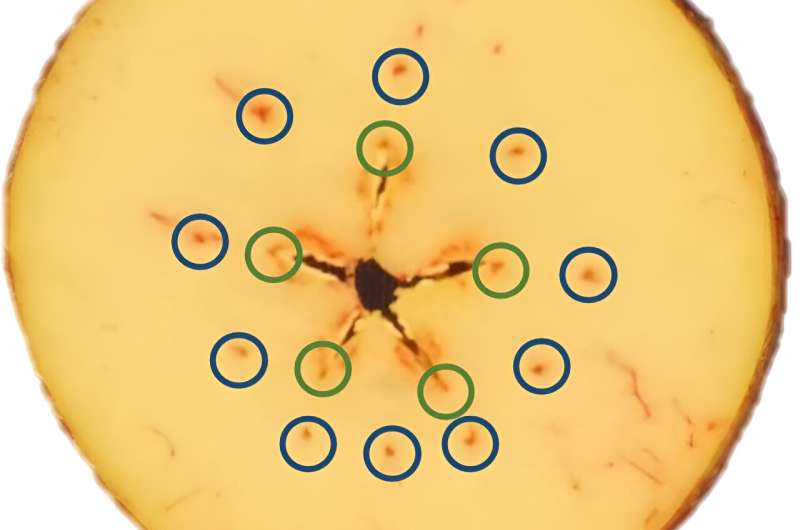This article has been reviewed according to Science X's editorial process and policies. Editors have highlighted the following attributes while ensuring the content's credibility:
fact-checked
peer-reviewed publication
trusted source
proofread
Xylem functionality is not a direct indicator of apple preharvest fruit drop: Study

Harvesting apple (Malus × domestica) fruit at optimal horticultural maturity is critical to meeting consumer preferences and to maintain quality throughout storage. Management during harvest is complicated by uneven ripening, overlapping maturity of cultivars, and lack of labor availability.
Exacerbating these complications is the tendency for apples to abscise prematurely before harvest [preharvest fruit drop (PFD). Preharvest is the second period in the growing season when fruit abscise from the tree, the first being immature fruitlet abscission 5 to 6 weeks after bloom, termed "June drop" in the Northern Hemisphere.
Apple (Malus × domestica) growers can incur significant economic losses when fruit drop before they can be harvested [preharvest fruit drop (PFD)]. In some years and cultivars, more than 30% of potential yield can be lost. Growers frequently apply plant bioregulators to reduce PFD, either via delay in maturity or via inhibition in production of cell hydrolysis enzymes in the fruit pedicel [naphthalene acetic acid (NAA)].
Finding a physiological indicator of PFD would allow growers to assess the susceptibility of fruit to PFD. Due to its lignification, xylem is believed to be the last tissue to break down in the fruit pedicel, leading to PFD.
To determine whether loss in xylem functionality can be used as an indicator of PFD potential, studies were conducted in 2020 and 2021 with "Red Delicious" treated with AVG (132 µL·L−1), NAA (10 µL·L−1), and an ethylene-producing compound [ethephon (150 µL·L−1 in 2020, 200 µL·L−1 in 2021)] to generate a range of PFD potentials. Xylem functionality was assessed in the fruit cortex. Internal ethylene content (IEC), fruit maturity indices, and PFD rates were quantified weekly throughout the harvest period.
In 2020 and 2021, AVG reduced PFD compared with the untreated control by decreasing IEC. Although ethephon did not result in higher PFD than untreated fruit, NAA reduced PFD in 2020 but not 2021. For all treatments in both years, there was a linear decrease in xylem functionality throughout the measurement period. Cumulative PFD exponentially decreased as xylem functionality neared zero and the climacteric rise in ethylene began. Concurrent with the rise in IEC and PFD was an increase in the expression of MdEG1 and MdPG2 in the fruit pedicel of the control compared with AVG-treated fruit.
The findings of a recent study, published in the Journal of the American Society for Horticultural Science, did not support the hypothesis that loss of xylem functionality directly leads to PFD.
Treatments that effectively limited PFD (AVG in 2020 and 2021; NAA in 2020) did not consistently maintain higher xylem functionality than treatments with substantial PFD. Loss of xylem functionality was not coincident with cell wall hydrolysis in the fruit pedicel. IEC was a better indicator than xylem functionality at the advanced maturity where fruit drop occurred in this study.
Increases in IEC, expression of cell-wall disassembly genes, and cumulative fruit drop were evident. Further analysis is necessary to determine if MdEG1 and MdPG2 in the pedicel/AZ can serve as useful markers to predict fruit drop in addition to ethylene biosynthesis-based tools. Together, such tools can help predict susceptibility to PFD.
More information: James E. Larson et al, Xylem Functionality Is Not a Direct Indicator of Apple Preharvest Fruit Drop, Journal of the American Society for Horticultural Science (2023). DOI: 10.21273/JASHS05302-23
Journal information: Journal of the American Society for Horticultural Science
Provided by American Society for Horticultural Science




















